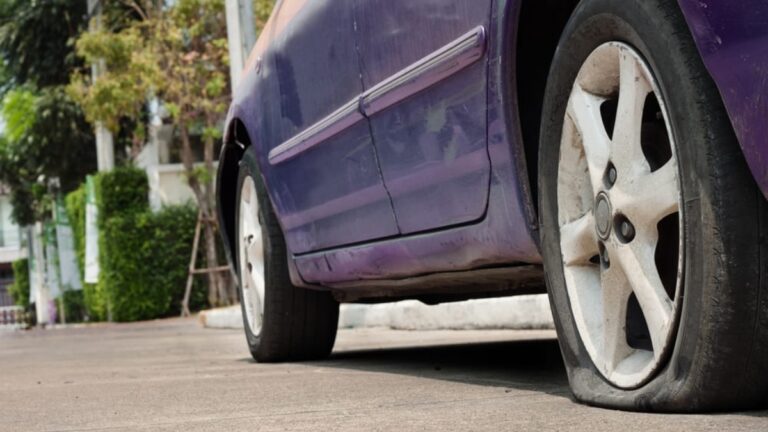Have you ever noticed your car riding a little rougher than usual, or felt a slight wobble while driving? Perhaps the tire pressure warning light flickered on your dashboard, only to disappear again after a few minutes. These could be signs of a slow leak in your tire, a silent thief slowly stealing away your ride’s smooth performance and safety.

Image: www.imcgrupo.com
A slow leak in a tire isn’t immediately catastrophic like a blowout, but it can cause a range of problems if left unchecked. It can lead to uneven tire wear, reduced fuel efficiency, and even a complete tire failure, potentially causing accidents. Understanding the causes, symptoms, and solutions for a slow leak is crucial for any responsible driver.
The Culprits: What Causes a Slow Leak?
The culprit behind a slow leak can be surprisingly small, often a microscopic puncture or a slow degradation of the tire’s rubber. Here are some common causes:
- Nail or Screw Punctures: These are the most common culprits. The sharp edge of a nail or screw pierces the tire tread, creating a small opening for air to escape.
- Road Debris: Sharp objects like glass shards, metal pieces, or even small stones can embed themselves in the tire, causing a slow leak over time.
- Tire Wear and Tear: Over time, the rubber of your tires can become brittle and develop small cracks, allowing air to escape slowly.
- Improper Tire Inflation: Under-inflation puts more pressure on the tire’s sidewalls, increasing the risk of slow leaks and accelerating wear.
- Corrosion: Metal parts on the wheels, like the valve stem, can corrode and weaken, leading to minor leaks around the valve stem.
- Rim Damage: A bent or damaged rim can cause a tire to sit unevenly, leading to pressure loss over time.
The Clues: Recognizing the Signs of a Slow Leak
Detecting a slow leak early can save you from a lot of hassle and potential danger. Keep an eye out for these telltale signs:
- Low Tire Pressure Warning Light: Though not always reliable, it’s a good initial indicator when accompanied by other symptoms.
- Tire Pressure Gauge Discrepancies: Regularly check your tire pressure using a tire pressure gauge and compare it to the recommended pressure listed in your owner’s manual.
- Uneven or Rough Ride: A slow leak can cause the tire to lose pressure, making the ride feel bumpy and unstable.
- Tire Wall Bulges: If you notice a bulge on the tire sidewall, it could be a sign of a major leak, potentially indicating tire damage.
- Tire Pressure Loss Over Time: If you notice a consistent drop in tire pressure after a few days, even after refilling it, it’s likely a slow leak.
- Noisy Ride: A slow leak in a tire can cause a noticeable humming or vibration noise as you drive, especially at higher speeds.
The Solutions: Tackling the Slow Leak
The best way to deal with a slow leak depends on its severity and the source. Here are some common solutions:

Image: www.corvetteforum.com
Temporary Fixes:
- Tire Sealant: This can temporarily fix small punctures by sealing the hole, allowing you to drive to a repair shop. Note: It won’t fix all types of leaks.
- Tire Plugs: Similar to sealant, but uses a rubber plug inserted into the puncture to seal the hole. It’s a more permanent solution but might not be suitable for sidewall punctures.
Permanent Solutions:
- Tire Patching: A professional mechanic can patch the puncture from the inside using a rubber patch, effectively sealing the hole. This is a reliable fix for most punctures.
- Tire Replacement: If the damage is severe, such as a sidewall tear or significant tread wear, replacement with a new tire is the only option.
- Valve Stem Repair: If the valve stem is the culprit, it can be replaced, ensuring proper sealing and preventing further leak.
- Rim Repair: A bent or damaged rim can be repaired or replaced to ensure a proper tire fit and prevent further pressure loss.
The Importance of Regular Maintenance
Prevention is always better than cure. Regular tire maintenance is crucial for catching slow leaks early and preventing bigger problems. Here’s what you can do:
- Regular Tire Inspections: Visual inspections for damage, cracks, or foreign objects embedded in the tread are essential.
- Regular Tire Pressure Checks: Use a tire pressure gauge to check your tire pressure regularly, at least once a month, and before each long drive. Make sure it’s at the recommended pressure for your vehicle.
- Tire Rotation: Rotate your tires every 5,000 to 7,500 miles to ensure even wear and prevent premature tire wear or leaks.
A Cautionary Tale: The Dangers of Neglecting a Slow Leak
Ignoring a slow leak can have serious consequences, jeopardizing your safety and causing unnecessary damage. Here’s why you shouldn’t take it lightly:
- Tire Failure: A slow leak can lead to complete tire deflation, resulting in a tire blowout while driving. This can cause loss of control, potentially leading to serious accidents.
- Uneven Tire Wear: Driving on an under-inflated tire puts extra stress on the tire, causing uneven wear and premature tire replacement. This can also affect the vehicle’s handling and steering.
- Increased Fuel Consumption: Under-inflated tires increase rolling resistance, which translates to reduced fuel efficiency. You end up spending more on gas and contribute to environmental pollution.
Slow Leak In Tire
The Bottom Line: Be Proactive for a Safe Ride
A slow leak in your tire may seem like a minor inconvenience, but it can quickly turn into a major headache. By regularly checking your tire pressure, conducting visual inspections, and taking proactive measures to address any issues, you can ensure a safe and enjoyable ride. Remember, a little preventive maintenance can go a long way in keeping your tires in top shape and your journey smooth and stress-free.





